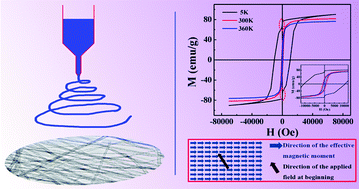Unique magnetic properties and magnetization reversal process of CoFe2O4nanotubes fabricated by electrospinning†
Abstract
CoFe2O4

* Corresponding authors
a
Key Laboratory of Magnetism and Magnetic Materials of Ministry of Education, Lanzhou University, Lanzhou 730000, P. R. China
E-mail:
xieeq@lzu.edu.cn
Fax: +86 9318912616
Tel: +86 931 8913554
b College of Physics and Electronic Information, Luoyang Normal College, Luoyang, P. R. China
c Nano Materials Group, School of Computing, Science and Engineering, University of Salford, Greater Manchester M5 4WT, UK
CoFe2O4

 Please wait while we load your content...
Something went wrong. Try again?
Please wait while we load your content...
Something went wrong. Try again?
J. Fu, J. Zhang, Y. Peng, J. Zhao, G. Tan, N. J. Mellors, E. Xie and W. Han, Nanoscale, 2012, 4, 3932 DOI: 10.1039/C2NR30487B
To request permission to reproduce material from this article, please go to the Copyright Clearance Center request page.
If you are an author contributing to an RSC publication, you do not need to request permission provided correct acknowledgement is given.
If you are the author of this article, you do not need to request permission to reproduce figures and diagrams provided correct acknowledgement is given. If you want to reproduce the whole article in a third-party publication (excluding your thesis/dissertation for which permission is not required) please go to the Copyright Clearance Center request page.
Read more about how to correctly acknowledge RSC content.
 Fetching data from CrossRef.
Fetching data from CrossRef.
This may take some time to load.
Loading related content
